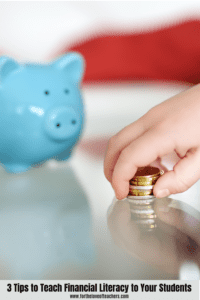Teachers have a big role to play in helping their students build their futures. Educators prepare kids for the near future, through the SATs and college applications, but they could also create a big impact on life after school. More specifically, teachers could help students make better financial decisions once they reach adulthood.
Importance of Learning Financial Literacy at an Early Age
Possibly every working adult would attest to the fact that making money is difficult. On the other side of the coin, money seems to disappear way faster than it takes to earn it. And when you add poor money management and a lack of financial literacy to this ironic mix, adult life can become even more challenging. Fortunately, today’s adults, especially teachers, can help break the cycle by teaching simple but helpful financial literacy lessons to students. Here are some reasons why it’s important to teach financial literacy to today’s youth:
You Need Money for Basic Needs
In some ways, the saying, “Money makes the world go round,” is true. Money is crucial for accessing basic needs like shelter and food. Lack of access to such basic necessities can affect other aspects of one’s life, including work performance and mental health. It’s important to teach kids that money may not be everything but that it’s an important means to live a more comfortable and healthy life. Not worrying about when one’s next meal will be or how one will pay the rent can help provide the ease of mind one needs to be able to focus on working on living a more well-balanced life.
Develop Habits That Stick
Good money management habits are easier to stick to when they’ve been ingrained in your daily life early on. And when these habits are practiced at a young age, they will become almost second nature when children grow to become working adults. On the other hand, when poor habits are formed as a child, they may be more challenging to unlearn. This can have a domino effect on other poor financial decisions. And the consequences of such decisions may be even more challenging to undo.
Raise Financially-Savvy and Resilient Children
You may have heard about or experienced first-hand the various scams that are becoming more believable and deceptive as technology evolves. On top of these scammers, there’s always the possibility of global financial crises or unexpected personal monetary challenges. Teaching financial literacy in schools may not solve every financial challenge, but it can help children learn how to be resilient and vigilant when it comes to their hard-earned money.
Three Tips to Teach Financial Literacy to Your Students
When these kids turn into adults, they only have themselves to rely on to make good life and financial decisions. Educators can help set their students up for a brighter and financially healthier adult life with these tips:
-
Customize Activities and Lesson Plans Based on Your Students’ Age Group
It’s essential to consider the students’ ages. A class of first-graders may not be the best group to teach more advanced concepts like what earned wage access is or how to compute compound interest charges. Make sure to use terms and concepts that can be easily digested by the age group of the class. This way, they will be more encouraged and empowered to practice good financial habits since they can actually understand the concepts. For example, students in the younger age range can be taught more simple concepts, including:
- The Difference Between Wants and Needs
- Spending and Saving
- Comparison of Similar Products with Different Price Points
- The Various Bills and Coins in Your Local Currency (with examples of what you can buy with them)
2. Make Learning Fun with Games
Learning financial literacy concepts can be easier when it’s done through a fun and educational game. You can have a board game day with well-loved games such as Monopoly or the Game of Life. These games can help teach students the value of being smart and patient with their money. The most expensive property may not be the best investment, and not having a strategy at all can lose you both the game and your (Monopoly) money.
3. Practice Financial Skills Through Charitable Projects
Students can also learn about financial literacy while helping a cause. Your students can form groups that will all work to raise money for their chosen charity. They will be in charge of the project from start to finish. This will include computing the needed resources, knowing where to get these resources, how to manage cash flows, and more. Aside from applying practical money management tips, projects like this one allow students to learn the value of teamwork and helping others. Additionally, computing the proceeds and donating them can be that much more rewarding since the students worked on the fundraiser from the beginning.
Teaching your students about financial literacy means you’re preparing them for a more financially secure future. It can be challenging to introduce financial concepts at first, but it will be worth it as your students will be bringing these lessons with them well after they leave the four walls of the classroom.
How do you teach financial literacy? Share in the comments.
About the Author: Kat is a Molecular Biology Scientist turned Growth Marketing Scientist. During her free time, she loves to write articles that will bring delight, empower women, and spark the business mind. She loves to bake but unfortunately, baking doesn’t love her back. She has many things in her arsenal and writing is one of her passion projects.
Thanks for reading!
If you like it, then pin it!

Christine Weis is a passionate educator, classroom management coach, wife, and mom of two busy boys. She enjoys teaching, writing, and creating resources for teachers.







Leave a Reply